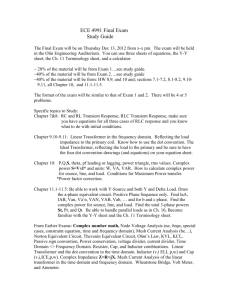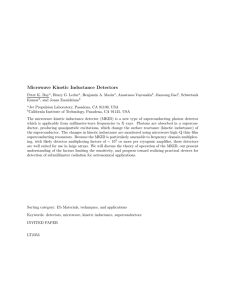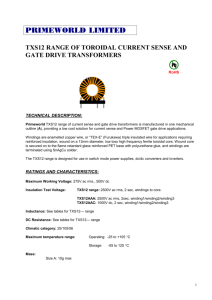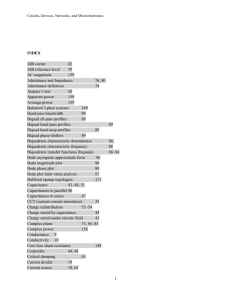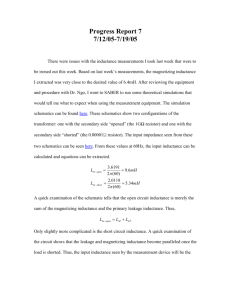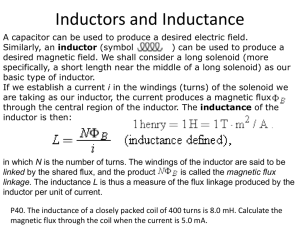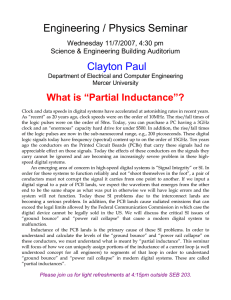Application Derived Inductor and Transformer University of Washington Ka - Wo Pang (Fred)
advertisement
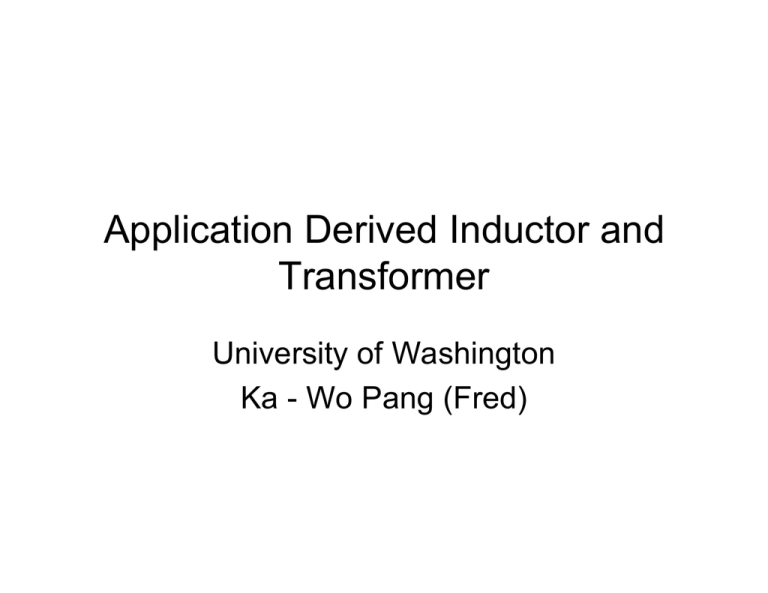
Application Derived Inductor and
Transformer
University of Washington
Ka - Wo Pang (Fred)
Outline
• Background and Motivation: Inductor
• Transformer design methodology
– Structures
– Layout technique
• Transformer example: LNA
– Design
– Layout
– result
• Future work and conclusion
Motivation
• Key components for RF circuits
• Hard for beginners
– How to construct the structure for specific
inductance and quality factor
– Matlab program
• Provide design technique for different
applications
– How parameters affect the results
• LNA: gain, noise figure
• PA: DC current handling
Inductor
• What is it?
– An element stores magnetic energy
– Amount of stored energy called Henry
– Lossless ideally
• Applications
–
–
–
–
–
Passive filter
Matching network
LC tuning
VCO, PA, LNA
Etc.
Integrated spiral inductor
• Inductance
– Greenhouse (1974)
n
n !1 n
i =1
i =1 i = 2
L = " Li + 2 " " M i , j
Grover (1964):
Line inductance (micro-henry):
L = 0.002l{ln[2l/0.2232(w+t)]-1.25+[(w+t)/3l]+(u/4)T}
Parallel mutual inductance (nano-henry):
M = 2l ln{ (l/GMD) + [1+( l2/GMD2)]0.5} – [1 + (GMD2/l2)]0.5 + (GMD/l)]
GMD = dek
Spiral Inductor Model
Cm
Rs
Ls
Cox
Oxide
Csi
Cox
Rsi
Rsi
Csi
Substrate
Standard PI model
High frequency Loss for Spiral
Inductor
• Resistive loss
– Skin effect
• Substrate loss
– Proximity effect
• Self resonant frequency
w=
1
LC
Wikipedia.com
Applications
• LC matching network
– Minimize the loss
– Self resonant frequency
• Power amplifier
– Bias current handling
• Metal current density
Transformer
• What is it?
– AC couple between
two inductors
• Applications
–
–
–
–
–
Energy transfer
Balun
Wideband circuits
Matching networks
Feedback circuits
Transformer Parameter
•
•
•
•
Quality Factor: Q = wLs/Rs
Coupling Factor: K = M/√(LsLp)
Number of Turns or ratio: n = √(Ls/Lp)
Self Resonant Frequency:
W0 = 1/ √(LsCtot)
Structure: Frlan Transformer
•Same layer
• primary and secondary
parallel with each other
•180 degree different
•Non-inverting (current
flows in the same direction)
Overlay Transformer
• Primary and secondary
in different layer
• Non-inverting
Concentric Transformer
• Same layer
• Inside and outside
configuration
• Various structures
Nested Transformer
• require transitional
layer
• Inverting
Structure Comparison
Frlan
Overlay
concentric
Nested
Coupling
(k)
med
high
low
med
Self Resonant
med
low
med
med
Inductance med
high
high
med
Type
Depends
Depends
symmetric
Nonsymmetric
Layout technique
•
•
•
•
•
•
Minimize no. of Vias (for inductance)
Maximize no. of Vias (for Quality factor)
Use the top layers
45 degree for angles
Use minimal separate distance
Quality Factor: Reduce Rs
– Increase metal width or thickness (typically 10u 20u)
• K and Self resonant frequency:
– depends on Structure
Simulation tools
• Asitic
– Fast
– less Accuracy (20% off)
– Good starting step
• ADS
–
–
–
–
Slow
High Accuracy
Final verification
Layout and model comparison
Asitic Setup
• Download the Unix setup from
http://rfic.eecs.berkeley.edu/~niknejad/a
sitic.html
• Follow the installing instructions
• To start the program: ./asitic_linux
• Build technology file .tek
• Tutorial on the website
Asitic: symmetric inductor results
R
W
G
a
p Side
S
N
Q1
L
R
C1
C2
R1
R2
SRF
100
10
10
15
8
3
4.98
1.56
1.38
33.7
34.1
131.
46.8
27.7
100
10
5
15
8
3
5.61
1.88
1.47
32.3
32.5
123.
53.1
23.7
100
5
10
15
8
3
2.81
2.12
3.31
29.3
29.1
220.
48.4
35.3
100
10
10
20
8
3
5.07
1.60
1.39
34.5
34.8
129.
47.0
26.7
200
10
10
15
8
3
8.20
5.11
2.71
76.8
76.9
60.1
48.8
8.25
200
10
10
15
8
5
9.56
9.40
4.23
103.
103.
56.9
51.1
5.19
200
10
10
15
6
3
7.88
4.79
2.65
75.0
755.
61.4
48.6
8.65
150
10
5
23.2
8
5
8.73
7.05
3.51
68.6
68.8
70.3
58.9
7.41
ADS setup
• Add source
/usr/nikola/groups/vlsi/pkgs/ads/ads.csh
rc (or ~robin/ads.cshrc) in .cshrc.local
• Start ADS command: ads
• Before use:
– Create technology file
– Create layout file
ADS sample results: concentric
structure
ADS sample results: Stack &
Concentric Structure
Example: Low Noise Amplifier
(LNA)
• Wide bandwidth (0.8 ~2.4GHz)
– Multi-mode operation
• Differential
• High gain
• Low noise (noise figure <3dB)
Design Process
• Transformer: less number of capacitor
array than Inductor
– Less parasitic from capacitor array
• Reasonable values
– Inductor: < 10nH
– Capacitor: < 20pF
• 0.8GHz : ~4nH , ~10pF
• 2.4GHz : ~1nH , ~4pF
Design Process
• LC Network Q
– usually dominated by the transformer
– Bandwidth of the network (Q=f0/BW)
• Gain
– gm*Rout
– Rs(1+Q2)
• Noise
– Proportional to K and Q
Design Process
• ASITIC
– Estimate the dimension and Inductance
• Create layout in Cadence
• Simulate the circuit in ADS
– Generate S-parameter results
• Compare layout result with model
– Find the best fit model for the transformer
Challenges
• Quality factor <10
– Lower than 10 with small inductance value at low frequency
– Negative resistance circuit
• High power consumption
• Positive feedback: reduce linearity
– Increase inductance value (increase area and SRF)
• Coupling and Self resonant frequency
– Usually require SRF 2 times higher than operation frequency
– Overlay structure: SRF is too low for the required inductance
– Nested Structure: both are medium
Transformer Summary
inductance (pri at 0.8GHz)
inductance (sec at 2.4GHz)
Q (pri at 0.8GHz)
Q (sec at 2.4GHz)
k (0.8 ~ 2.4GHz)
area (um x um)
Metal Width (um)
Number of Turns
Metal Space (um)
inductance (pri at 0.8GHz)
inductance (sec at 2.4GHz)
Q (pri at 0.8GHz)
Q (sec at 2.4GHz)
k (0.8 ~ 2.4GHz)
area (um x um)
Metal Width (um)
Number of Turns
Metal Space (um)
concentric (inv)
Frlan (inv)
6.2nH
3.6nH
1nH
1.6nH
9
7
13.5
17
0.4~0.54
0.7~0.75
360 x 360
375 x 360
15
15
4:2
4:2
5
5
frlan (non-inv) frlan - stack (non-inv)
4nH
5nH
0.5nH
0.5nH
7
9
8
11.5
0.67~0.72
0.64~0.72
320 x 320
360 x 360
15
15
4:1
4:1
5
5
frlan (inv)
5.5nH
1nH
7
14
0.55~0.66
360 x 360
15
4:2
5
Layout in ADS
Transformer Model
Model VS S-parameter
Out+
R2
R1
C1
L1
C1
vbias 1
• Wide - band input matching
using common - gate LNA
L1, C1: 6n, 6.6p – 0.8 GHz.
L2, C1, C2: 1n, 0.4p, 2p
– 2.4 GHz.
V1
1
I
R1
L1
L2
L2
C2
C2
R2
V2
2
I
LNA
Out-
• Tunable output load from
0.8GHz - 2.5GHz
• Primary inductance: ~5n
• Secondary inductance: ~0.5n
vbias 2
In+
In-
Resonator Corners @ 0.8
Slow
Fast
GHzTyp
S21 (dB)
19
25.0
32.4
Volt. Gain (dB)
22.5
28.5
36
S11 (dB)
< -15
<-15
<-12
NF (dB)
6.6
6.7
5.8
Power (mW)
(4.2+3.8)
*1.2 =9.6
(4.8 + 5.6)*1.2 =12.5
(5.4+7.6)*1.2 =
15.6
Q (using neg.
FB)
18
32
80
IIP3 (dBm)
-10.9
-16.32
-22.22
Corners
@
2.4
GHz
(No
Q‐enhancement)
Slow
Typ
Fast
S21 (dB)
19
20.75
21.75
Volt. Gain (dB)
22.5
24.35
25.5
S11 (dB)
< -15
<-15
<-15
NF (dB)
3.05
2.6
2.4
Power (mW)
(4.2) *1.2 =5
(4.8)*1.2 =5.76
(5.4)*1.2 = 6.5
Q
8
8
8
IIP3 (dBm)
-0.6
-2.78
-6.54
Future work
• Matlab program
– Enter inductance and dimension
– Output different structures with appropriate
turns, metal width
– Q plot of different structures
• Tunable matching network
– Power amplifier
Tunable Notch Filter
LO
Notch Filter
Band-Pass
Filter
X
Gain
Block Diagram:
Low-Pass
Filter
Algorithm
25
Tunable Notch filter:
ADC
DAC
Filter results
•
•
•
•
•
•
Notch Filter: 1.2GHz ~45dB
Band-Pass: 1.2GHz ~0dB
Mixer :1.2GHz
Gain : 40dB
LPF: 150MHz
ADC: 4 bit -0.4~0.4 input range,
250MHz/sample
• Tuning range: 1.2 ~1.45GHz

